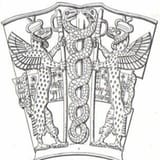Search Results
6/29/2025, 9:38:03 AM
>>17800076
>Ninazu (Sumerian: 𒀭𒎏𒀀𒋢; [DNIN.A.SU] "lord healer") was a Mesopotamian god of the underworld. He was also associated with snakes and vegetation, and with time acquired the character of a warrior god. He was frequently associated with Ereshkigal, either as a son, husband, or simply a member the same category of underworld deities
>According to Julia M. Asher-Greve, Ninazu was initially considered a "high-ranking local god", similar in rank to Ningirsu (Ninurta). His name has Sumerian origin and can be translated as "lord healer", though he was rarely associated with medicine. It is nonetheless agreed that he could be considered a healing deity. He was regarded as the "king of the snakes" and as such was invoked in incantations against snakebite. Many of such texts were written in Elamite and Hurrian, rather than in Sumerian or Akkadian, even though they originated in Enegi. He was also associated with vegetation and agriculture
>A single god list from the first millennium BCE equates Ninazu with Ninurta, and his spouse Ningirida with Gula. An association between him and the latter goddess is also attested in the Gula Hymn of Bulluṭsa-rabi, composed at some point between 1400 BCE and 700 BCE (between the Kassite and Neo-Babylonian period). This text is considered an aretalogy and it might reflect the development of a form of henotheism in late theological traditions
>As noted by Irene Sibbing-Plantholt, while it has been argued in the past that "this interpretation of Ninazu as a spouse of Gula goes back to the merge of Ninazu with Ninurta/Ningirsu (as son of Enlil and Ninlil), (...) this connection may also have been established through the link between (U)kulla(b), Ninazu’s spouse, and Gula." Frans Wiggermann notes that the hymn presents an "aberrant," otherwise unknown, genealogy of Ninazu, calling him "offspring of Mami," which according to him might entirely depend on implicit identification with Ninurta in this context
>Ninazu (Sumerian: 𒀭𒎏𒀀𒋢; [DNIN.A.SU] "lord healer") was a Mesopotamian god of the underworld. He was also associated with snakes and vegetation, and with time acquired the character of a warrior god. He was frequently associated with Ereshkigal, either as a son, husband, or simply a member the same category of underworld deities
>According to Julia M. Asher-Greve, Ninazu was initially considered a "high-ranking local god", similar in rank to Ningirsu (Ninurta). His name has Sumerian origin and can be translated as "lord healer", though he was rarely associated with medicine. It is nonetheless agreed that he could be considered a healing deity. He was regarded as the "king of the snakes" and as such was invoked in incantations against snakebite. Many of such texts were written in Elamite and Hurrian, rather than in Sumerian or Akkadian, even though they originated in Enegi. He was also associated with vegetation and agriculture
>A single god list from the first millennium BCE equates Ninazu with Ninurta, and his spouse Ningirida with Gula. An association between him and the latter goddess is also attested in the Gula Hymn of Bulluṭsa-rabi, composed at some point between 1400 BCE and 700 BCE (between the Kassite and Neo-Babylonian period). This text is considered an aretalogy and it might reflect the development of a form of henotheism in late theological traditions
>As noted by Irene Sibbing-Plantholt, while it has been argued in the past that "this interpretation of Ninazu as a spouse of Gula goes back to the merge of Ninazu with Ninurta/Ningirsu (as son of Enlil and Ninlil), (...) this connection may also have been established through the link between (U)kulla(b), Ninazu’s spouse, and Gula." Frans Wiggermann notes that the hymn presents an "aberrant," otherwise unknown, genealogy of Ninazu, calling him "offspring of Mami," which according to him might entirely depend on implicit identification with Ninurta in this context
Page 1
